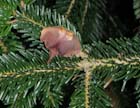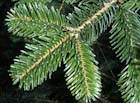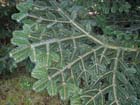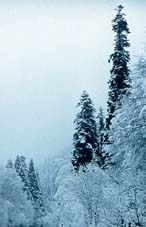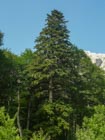Conservation Status

(subsp. nordmanniana)

(subsp. equi-trojani)
Abies nordmanniana
(Steven) Spach 1841
Common names
Caucasian fir; Pikhta kavkazkaya (Farjon 1990).
Taxonomic notes
Synonymy:
- Pinus nordmanniana Steven 1838;
- Picea nordmanniana (Steven) Loudon 1842;
- Pinus abies var. nordmanniana (Steven) Mueller 1871;
- Abies leioclada (Steven) Gordon;
- A. pectinata var. leioclada (Steven ex Endl.) Carr. 1855.
One subspecies, equi-trojani (Aschers. et Sint. ex Boiss.) Coode et Cullen. Synonyms for subspecies equi-trojani (Silba 1986, Farjon 1990, Vidakovic 1991):
- A. cephalonica var. apollinis (Link) Beissner;
- A. nordmanniana var. equi-trojani Guinier et Maire;
- A. nordmanniana subsp. equi-trojani (Asch. et Sinb.) Coode et Cullen;
- A. pectinata Lam. et DC. var. equi-trojani Aschers. et Sint. ex Boiss.;
- A. bornmuelleriana Mattfeld 1925;
- A. cephalonica var. graeca (Fraas) Liu.
Vidakovic observes that: "[a]ccording to Flous (1936), A. bornmüelleriana is a hybrid between Greek and Caucasian fir, while Mattfeld (1930) believes it is a transitional type between the silver fir and Greek fir" (Vidakovic 1991). Vidakovic suggests that "throughout the entire Caucasus and north Turkey only one species occurs--A. nordmanniana" (Vidakovic 1991).
Farjon provides some further insights to the taxonomic disputes about this group of firs, noting that subspecies, equi-trojani "has been treated as a species by Mattfeld (1925). Earlier proposals to relate it to A. cephalonica or even A. alba have been abandoned by Davis et al. (1965) and Nitzelius (1969), but were again made by Liu (1971)" (Farjon 1990). He also concludes that "[t]he geographically separated populations in W and N Turkey, described under the above mentioned names and at various taxonomic levels, are found to be entirely clinal (Nitzelius, 1969)" (Farjon 1990).
Description
Evergreen tree to 61 m tall, densely branched from ground up, branches regularly arranged. Bark grey-brown, smooth with resin blisters until very old. Needles dense, directed forward, 20-30 mm long, 2-2.5 mm wide, apex rounded and notched, lustrous dark green above, 2 white stomatal bands below, buds not resinous. Cones red-brown, 15 cm long and 5 cm wide, cylindrical (Oregon State University 2003, University of Connecticut 2001). See García Esteban et al. (2004) for a detailed characterization of the wood anatomy.
Subsp. equi-trojani is described as "[a] narrowly conical tree 20-30 m tall, 1.8-4 m girth, with a somewhat rounded crown. Bark thick, divided into scaly plates, yellowish grey-brown. Branchlets shiny yellowish brown to orange-brown, non-pubescent. Buds ovoid, chestnut brown, resinous, scales free at the apex, apex obtuse, 1-1.2 mm diameter. Needles densely set, irregularly disposed, mostly lying forward and crowded on upper side of branchlet, curving upwards on the lower side of the branchlets, grooved above near the base, 15-30 mm long by 1.5-2 mm wide, 2 white stomatal bands below with 6-8 lines, apex pointed or obtuse. Female cones cylindric-ovoid, reddish-brown to dark brown, apex ovoid, to 10 cm long by 4-4.5 cm wide; bracts long exerted and reflexed, sharp pointed, lobed. Seeds to 6 mm long, to 22 mm long with wing." It is found in Greece: Mt. Parnassus to W. Anatolia, Turkey, at 760-2000 m (Silba 1986).
Distribution and Ecology
The typical subspecies occurs in W Caucasia (Abkhazia, Georgia) and in the mountains of NE Turkey and N Turkey (Paphlagonia). Introgression with ssp. equi-trojani forms in the western part of its range. It grows in mountains around the E Black Sea at 900-2100 m, on silicic soils. The climate is continental and wet, with annual precipitation of 1000-3000 mm. It occurs in pure stands or mixed with Picea orientalis, Pinus sylvestris, Fagus orientalis, Acer trautvetteri, Carpinus caucasica, Ulmus elliptica, Acer pseudoplatanus, Tilia caucasica, Taxus baccata and Rhododendron ponticum (Farjon 1990).
Distribution of Abies in the Mediterranean region. Data from Conifers of the World BRAHMS database, downloaded 2017.11.05. Taxa are color coded; see pull-out menu at left of map for details. Click on each occurrence for further information.
Subsp. equi-trojani grows in pure stands as isolated relict populations on N slopes of high mountains in W Turkey and on Ulu-Dagh in Bithynia. It prefers calcareous soils (Farjon 1990).
Hardy to Zone 4 (cold hardiness limit between -34.3°C and -28.9°C) (Bannister and Neuner 2001, subspecies not specified).
Remarkable Specimens
Currently the largest diameter (185 cm) is recorded for a tree in New Zealand, and the greatest height (60.5 m) for a tree in Russia. The following data describe the largest known trees within the species' native range. These data were collected in the 21st Century by Kouta Räsänen, a highly experienced investigator, and can be presumed highly accurate.
- 145 cm dbh and 59.5 m tall for a tree at Хребет Буйны памятник природы (Bunyy Range National Monument) in Russia; laser height measurement (Monumental Trees 2018a).
- 140 cm dbh and 60.5 m tall for a tree at Кавказский заповедник (Caucasus Nature Reserve) in Russia; laser height measurement (Monumental Trees 2018a).
- 123 cm dbh and 58.9 m tall for a tree at Кавказский заповедник (Caucasus Nature Reserve) in Russia; laser height measurement (Monumental Trees 2018b).
- 104 cm dbh and 50.2 m tall for a tree at Borjomi Strict Nature Reserve, Georgia; laser height measurement (Monumental Trees 2014).
The trees pictured at right, photographed by Eduard Gerlakh in the Caucasus, are examples of the big Russian trees. There was also one record of a tree on the Mzymta River, Caucasus National Reserve, Russia, as being 78 m tall and 360 cm dbh (Vladimir Dinets e-mail 1998.01.02). If accurately measured, this would be the largest Abies known. However, it may be that the 360 cm figure represents girth rather than diameter, and the height is also uncertain, predating laser measurements. Moreover, the entire area was logged to clear land for the Sochi Olympics in 2014 (Kouta Räsänen email 2018.01.13, reporting conversation with Dinets). Finally, some large trees are reported from the mountains in a forest reserve, Örümcek Ormanı Göknarı located in Turkey at approximately 40.67° N, 39.04° W. Circumstances of the measurement of these trees are not reported (they may have been measured in 1995), nor are locations, so they must be treated as anecdotal; but they report heights of up to 58.5 m and diameters of up to 193 cm (Agaclar.net, no date). Certainly the area seems to warrant a visit.
The following data describe the largest reported trees located outside of the native range.
- 185 cm dbh and 47 m tall with about a 20 m crown spread for a tree at Mararewa near Tapawera, New Zealand; laser height measurement (Cadwallader 2023).
- 165 cm dbh and 32 m tall for a tree at Endsleigh, Devon (UK) (Mitchell et al. 1990).
- 159 cm dbh and 51.60 m tall for a tree at the Vallombrosa botanical garden, Reggello, Italy (Monumental Trees 2016a).
- 148 cm dbh and 36 m tall for a tree of subsp. equi-trojani in Tacoma, Washington, USA (Robert Van Pelt e-mail 1998.12.03).
- 121 cm dbh and 50 m tall for a tree at Cragside House, Northumberland, UK (Monumental Trees 2016b) - this is almost certainly the same tree reported by Mitchell et al. (1990) as being 107 cm dbh and 47 m tall, but the current measurement is from 2016.
The oldest known specimen is documented in a tree-ring chronology covering the period 1498-2007 (crossdated after 1522); it was collected in extreme northeastern Turkey by N. Köse and H. T. Güner (doi.org/10.25921/n8ds-rc18). The oldest tree in the study provided a 500-year record. The ring-width record ended in 1997, so I presume this tree was dead. This collection was used in a dendroclimatic reconstruction of temperatures (Köse et al. 2017).
Ethnobotany
On 2003.09.02, I received the following e-mail, which is here quoted largely unedited (although I did help the author a bit with his English):
"I am Irakli Lekvinadze from the Republic of Georgia (Caucasia). I have recently read your web site and decided to co-operate with you. I am your colleague and I provide my own family business. I am busy with growing Abies Nordmanniana. Every year in September and October with the employeed local peasants I gather cones in the high mountain region "Racha" (where these trees grow wild), mill the cones and grow the trees. I sell them at Christmas. Despite the fact that peasants do not ask for much as their salary and the prices of the trees and seeds are low, my business is not large. This has its double reason: For the one hand Georgia is in the group of developing countries and the huge part of the population is still in the extreme poverty, so only some afford to buy and decorate trees at Christmas Eve, and for the other, there are some people who unconsciously cut trees breaking law and destroying the nature. These very people do not leave me the chance to increase by business. ... E-mail: irakligrinwood@rmbler.ru"
Observations
No data as of 2023.02.22.
Remarks
Discovered to European science by Alexander von Nordmann, Finnish botanist (1803-1866), who introduced it to western Europe in 1838, and for whom it is named (Oregon State University 2003).
Citations
Agaclar.net. [No date.] Gümüşhane. http://www.agaclar.net/?id=showthread&t=14009, accessed 2017.08.13.
Cadwallader, Brad. 2023. New Zealand Notable Trees Trust, data for tree TNR/0696. http://register.notabletrees.org.nz/tree/view/696, accessed 2023.10.23.
Farjon, Aljos. 1990. Pinaceae: drawings and descriptions of the genera Abies, Cedrus, Pseudolarix, Keteleeria, Nothotsuga, Tsuga, Cathaya, Pseudotsuga, Larix and Picea. Königstein: Koeltz Scientific Books.
Flous, F. 1936: Classification et evolution d'un groupe d'Abietinées. Travaux Labor. Ford. Toulouse, Tome I, Vol. II, Article XVIII.
Köse, Nesibe, H. Tuncay Güner, Grant L. Harley, and Joel Guiot. 2017. Spring temperature variability over Turkey since 1800 CE reconstructed from a broad network of tree-ring data. Climate of the Past 13(1):1-15. doi: 10.5194/cp-13-1-2017
Mattfeld, J. 1930: Über hybridogene Sippen der Tannen. Bibliotheca Botanica 100:1-84, Stuttgart.
Monumental Trees. 2014. Nordmann fir in the Borjomi Strict Nature Reserve in Likani. Available: https://www.monumentaltrees.com/en/geo/samtskhe-javakheti/borjomi/9778_borjomistrictnaturereserve/, accessed 2017.08.10.
Monumental Trees. 2016a. Nordmann fir 'Nazareno' in the Vallombrosa botanical garden in Vallombrosa. Available: https://www.monumentaltrees.com/en/ita/tuscany/reggello/14136_vallombrosabotanicalgarden/, accessed 2017.08.10.
Monumental Trees. 2016b. Nordmann fir on the grounds of Cragside House. Available: https://www.monumentaltrees.com/en/gbr/england/northumberland/4302_cragsidehouse/8732/, accessed 2017.08.10.
Monumental Trees. 2018a. Monumental trees in Khrebet Buynyy pamyatnik prirody in Guzeripl, Adygea, Russia. Available: https://www.monumentaltrees.com/en/rus/adygey/maykopskiy/19772_khrebetbuynyypamyatnikprirody/, accessed 2018.08.30. Good photos posted here as well.
Monumental Trees. 2018b. Nordmann firs in Kavkazskiy Zapovednik in Guzeripl, Adygea, Russia. Available: https://www.monumentaltrees.com/en/rus/adygey/maykopskiy/19771_kavkazskiyzapovednik/, accessed 2018.08.30. Good photos posted here as well.
Oregon State University. 2003. Landscape Plants, Vol. 2. http://oregonstate.edu/dept/ldplants/abno.htm, accessed 2003.09.02.
University of Connecticut. 2001. University of Connecticut Plant Database.
http://www.hort.uconn.edu/plants/a/abinor/abinor1.html, accessed 2003.09.02, now defunct.
See also
Arbez, M. 1969. Réparation, écologie et variabilité des sapins de Turquie du nord: Abies Nordmanniana Spach, Abies Bornmuelleriana Mattfeld, Abies equi-trojani Ascherson et Sintenis. Ann. Sci. forest. 16 (2):257-284.
Arbez. M. 1967. Étude des liaisons entre précocité du débourrement, diametre, hauteur et apparition du burgeon terminal, chez de jeunes plants de sapin en pepénière. Bull. Soc. Bot. France 114:15-22.
Arbez, M. 1967. Abies Nordmanniana Spach, Abies Bornmuelleriana Mattfeld. Ann. Sci. forest. 24:121-156.
Elwes and Henry 1906-1913 at the Biodiversity Heritage Library. This series of volumes, privately printed, provides some of the most engaging descriptions of conifers ever published. Although they only treat species cultivated in the U.K. and Ireland, and the taxonomy is a bit dated, still these accounts are thorough, treating such topics as species description, range, varieties, exceptionally old or tall specimens, remarkable trees, and cultivation. Despite being over a century old, they are generally accurate, and are illustrated with some remarkable photographs and lithographs.

